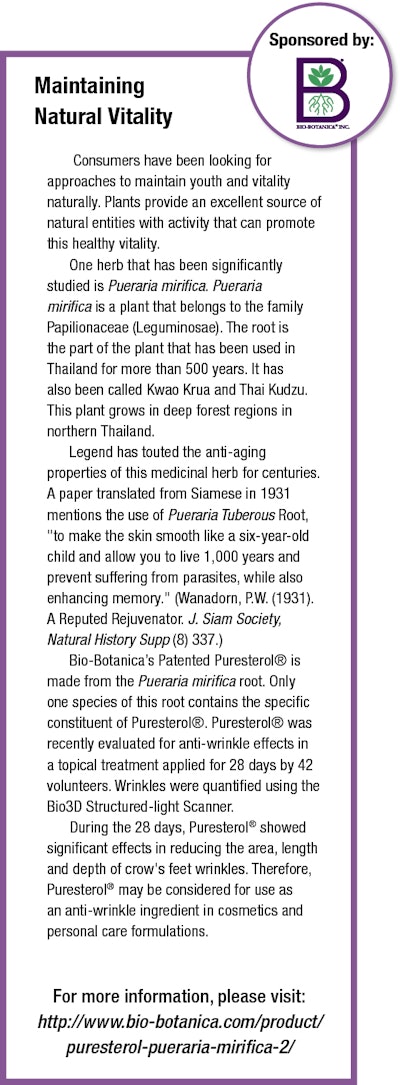
Read the full article in the April 2021 digital edition. . .
Historically, the primary focus for anti-aging skin care has been the face; although some research publications, consumer education and products have targeted aging skin needs on other body sites, including the neck, chest, arms, hands and legs. With the rising cultural shift to total body well-being, the needs of body skin have emerged as a trend that may be here to stay. This review focuses on non-facial skin aging considerations and implications for developing efficient products targeting this unmet consumer need.
Skin Aging
Skin aging on all parts of the body is caused by both intrinsic and extrinsic factors. As is well-known, intrinsic aging is a natural chronological, physiological process influenced by genetics, ethnicity, hormones and anatomical variations. On the other hand, extrinsic aging is stimulated by external environmental factors such as pollution, smoking, sun exposure, repetitive muscle movement, poor nutrition and other lifestyle choices.1
Sidebar: Maintaining Natural Vitality
Based on the anatomical site, the skin may be affected by both intrinsic and extrinsic factors in varying capacities.2 This is notably the case for non-facial skin, which may be less exposed to environmental factors and extrinsic aging but is heavily influenced by the physiology of the location of the skin on the body.
That said, a product developed for the needs of the face may not be optimal for the skin on the chest. As such, it is important to understand the anatomical site variations in facial skin relative to the skin on other body sites in order to establish a tailored, site-specific approach to anti-aging skin care for the unique needs of body skin.
Facial vs. Body Skin
The main differences between facial and body skin are thickness; sebaceous gland, sweat gland and hair follicle distribution; subcutaneous fat content; melanin composition; and response to external sensitivity.3 In non-facial body skin, the distribution of sebaceous glands drops substantially, with smaller glands and a lower count on the extremities.3 Accordingly, the high lipid content from sebum secreted by sebaceous glands are limited in those areas, resulting in the skin being dryer than the face.
Epidermal thickness also varies in body skin. For example, the skin on the dorsal forearm has a thicker stratum corneum, with more layers of corneocytes than the face. This contributes to a slower cellular differentiation rate, which may result in a rougher, uneven surface microrelief.4
In addition, some locations on the body such as the legs and abdomen are often more protected from external stressors such as UV, and therefore have less melanin variability.5 However, for areas exposed to the sun such as the neck, chest and top of the forearm, there may be even less melanin distribution, resulting in an uneven skin tone.
The skin on the body is also less sensitive to external stimuli, especially areas with a thicker epidermis.3 Finally, subcutaneous fat compositions vary on different parts of the body, with less deposition on the top of the hands and chest, which impacts the appearance of plumpness and/or smoothness in those areas.6
Physiological Aging of Non-facial Skin
Similar to the face, skin on the body undergoes both structural and biochemical changes with age. The stratum corneum decreases in thickness, particularly on the neck, upper part of the chest and the extensor surface of the hands.4 Keratinocytes become shorter and fatter, while corneocytes increase in size as a result of decreased epidermal differentiation. Melanocyte production decreases, which results in uneven skin tone, pigmentation and age spots.7
. . .Read more in the April 2021 digital edition. . .
References
- Farage, M.A., Miller, K.W., Elsner, P. and Maibach, H.I. (2008). Intrinsic and extrinsic factors in skin ageing: a review. Int J Cosmet Sci 30(2) 87-95. https://pubmed.ncbi.nlm.nih.gov/18377617/
- Trojahn, C., Dobos, G., Lichterfeld, A., Blume-Peytavi, U. and Kottner, J. (2015). Characterizing facial skin ageing in humans: disentangling extrinsic from intrinsic biological phenomena. Biomed Res Int 2015. https://www.hindawi.com/journals/bmri/2015/318586/
- Yoo, M.A., Seo, Y.K., Shin, M.K. and Koh, J.S. (2015, Mar 20). How much related to skin wrinkles between facial and body site? Age-related changes in skin wrinkle on the knee assessed by skin bioengineering techniques. Skin Res Technol 22(1)69-74. https://onlinelibrary.wiley.com/doi/abs/10.1111/srt.12230
- Sandby-Møller, J., Poulsen, T. and Wulf, H.C. Epidermal thickness at different body sites: relationship to age, gender, pigmentation, blood content, skin type and smoking habits. (2003). Acta Derm Venereol 83(6) 410-413. https://www.medicaljournals.se/acta/content/abstract/10.1080/00015550310015419
- Del Bino, S., Duval, C. and Bernerd, F. (2018, Sep 8). Clinical and biological characterization of skin pigmentation diversity and its consequences on UV impact. Int J Mol Sci 19(9) 2668. https://www.mdpi.com/1422-0067/19/9/2668
- Sepe, A., Tchkonia, T., Thomou, T., Zamboni, M. and Kirkland, J.L. (2011) Aging and regional differences in fat cell progenitors / a mini-review. Gerontology 57(1) 66-75. https://www.karger.com/Article/Abstract/279755
- Farage, M.A., Miller, K.W., Elsner, P. and Maibach, H.I. (2013, Jan 17). Characteristics of the aging skin. Adv Wound Care (New Rochelle) 2(1) 5-10. https://www.liebertpub.com/doi/10.1089/wound.2011.0356












